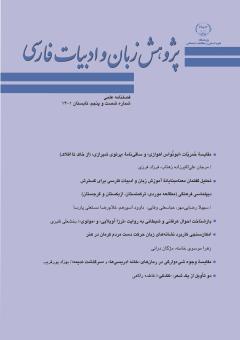بازشناخت احوال عرفانی و شیطانی به روایت «ترزا آویلایی» و «مولوی»
محورهای موضوعی : پژوهشهای ادبیات کلاسیک ایران
1 - دانشیار گروه فلسفه، ادیان و عرفان دانشگاه آزاد اسلامی تهران مرکزی
کلید واژه: معرفتشناسی عرفانی, احوال عرفانی, احوال شیطانی, ترزا آویلایی, مولوی.,
چکیده مقاله :
از منظر نگرشهای معنوی، یکی از تقسیم بندیهای احوال درونی انسان، عرفانی و شیطانی است. شناخت این احوال به ویژه احوال عرفانی و شیطانی از مباحث مهم معرفت شناسی عرفانی بوده، خود عارفان هم به این امر تفطن داشته اند. «ترزا آویلایی» (1515- 1582 م.) و «مولوی» (604- 672 ق.) در آثارشان کم و بیش به این امر پرداخته اند. استخراج و مقایسۀ نظرهای این دو عارف می تواند در شناخت احوال حقیقی و کاذب عرفانی کمک شایانی کند. بررسی این مسئله نشان میدهد که هر دو عارف، منشأ اصلی احوال حقیقی عرفانی را خدا و منشأ احوال کاذب را شیطان و توهم آدمی می دانند و با عروض احوال عرفانی، تسلّیّاتی هم برای انسان ارزانی می شود که آنها هم به دو دسته عرفانی و شیطانی تقسیم می شوند. ظاهراً هم ترزا و هم مولوی، هر دو بر این نظرند که احوال اصیل ناظر به آینده، قابلیت تحقق دارند، اما احوال کاذب در حد اموری ذهنی یا بیانی باقی می مانند. سخنان ترزا در این زمینه دقیق تر و جزئی تر از مولوی است. هر دو عارف در مواردی برای تشخیص احوال حقیقی از احوال کاذب، آزمودن شخصی را پیشنهاد می کنند؛ يعني تا زماني كه خود شخص چنين احوالي را از سر نگذراند، نميتواند ساير موارد را تشخيص دهد. مولوی در این زمینه از تشخيص اصالت يك حال عرفاني از طريق حال عرفاني ديگر یاد می کند که با نظر ترزا شباهت دارد. به اعتقاد هر دو عارف، احوال حقیقی، انسان را از اسارت دنیا رها می سازد، در حالی که احوال کاذب، انسان را اسیر دنیا و خواهش های نفسانی میکند. بهره گیری از معیارهای آشکار نبودن القائات دروغين و شباهتشان به رؤيا، در دسترس بودن احوال کاذب و دور از دسترس بودن احوال عرفانی و امکان راستی آزمایی آنها در نماز و نیایش می تواند در تشخیص این احوال کمک کند. غيرمنتظره، انتساب ناپذیر بودن احوال ناب به خود و معطوف ساختن توجهات انسان به خدا، تقویت اخلاق و دین داری، از شاخصه های احوال عرفانی است. در بیان این شاخص ها، ترزا دقیق و جزئی نگر و مولانا اغلب کلی نگر است.
Human inner can have three states; psychological, mystical and satanic states. Cognition of these states, especially mystical and satanic states has been one of the important topics of mystical epistemology, and the mystics themselves have been awared in this matter. Teresaof Avila (1515-1582 AD) and JalālaldīnRūmī (604-672 AH) have more or less dealt with this matter in their works. Extracting and comparing the opinions of these two mystics can help more in recognition of the true and false mystical states.The study of this issue showed that both mystics consider the God as the main source of the true mystical state and the devil and the illusion of man as the source of false stateandemerge the consolations to human beings can be given withthemysticalstates; which are also divided into two categories: mystical and satanic. Apparently Teresa and Rumi both believe that genuine status can be realize to the future, but the false states remain in the realm of mental or expressive matters. Teresa's speeches are more precise and slight than Rumi in this feild.Both mystics suggest personal testing in some cases to distinguish true states from false states; That is, until the person himself hasn’t spent through such states, he can not recognize other cases.In this feild, Rumi mentions the authenticity recognition of a mystical state through another mystical state, which is similar to Teresa’s idea. According to both mystics, real statefrees the human from the captivity of the world, whereas the false statecaptureshuman into the world and carnal desires. Enjoying the criterions of the lack clarity of inductions, false, (locution) and their similarity to the dream, the availability of false state and far from the availability of mystical states and the possibility of verifying them in prayer and supplication can help in recognizing these states. Unexpected, the non-attribution of pure states to oneself and turning one's attention to God, reinforcing morality and religiosity are the indicators of mystical states.
استیس، والتر ترنس (1388) عرفان و فلسفه، ترجمه بهاءالدین خرمشاهی، تهران، سروش.
پورجوادی، نصرالله (1385) زبان حال، تهران، هرمس.
جیمز، ویلیام (1391) تنوع تجربه دینی، ترجمه حسین کیانی، تهران، حکمت.
رحیمیان، سعید (1388) مبانی عرفان نظری، تهران، سمت.
قنبری، بخشعلی (1386) «راه¬های رابطه انسان با خدا از نظر ترزا و مولوی»، پژوهشنامه ادیان، شماره 1، صص 139-167.
------------ (1388) «اخلاق عرفانی سلبی به روایت ترزا آویلایی و مولوی»، پژوهشنامه ادیان، سال سوم، شماره 6، صص 89ـ109.
------------ (1390الف) «اخلاق ایجابی عرفانی به روایت ترزا آویلایی و جلال¬الدین مولوی»، پژوهشنامه ادیان، شماره 10، صص 129 ـ 155.
------------ (1390ب) «بررسی مقایسه¬ای دژ هوش¬ربای مولوی و دژ درون ترزا آویلایی»، مطالعات عرفانی، شماره 13، صص 161 ـ 184.
مولوي، جلال¬الدين محمد (1380) فيه ما فيه، به كوشش بديع¬الزمان فروزانفر، تهران، اميركبير.
------------------- (1363الف) كليات شمس تبريزي (10جلد)، تصحيح بديع¬الزمان فروزانفر، تهران، اميركبير.
------------------- (1363ب) مثنوي معنوی، به کوشش رینولد نیکلسون، تهران، امیرکبیر.
Chapman, J. (1956) "Mysticism" (Christian,Roman Catholic)" Encyclopaedia of Religions and Ethics, (ed) James Hastings, Vol.9.
Faning, Steven (2001) Mystics of the Christian, Tradition, London, & New York.
Parrinder, Geoffery (1996) Mysticism in the World's Religions, Oxford.
Smith, Margaret (1973) An Introduction To The History of Mysticism Amsterdam Philo Press.
Spencer, Sidney (1963) Mysticism In World Religion, Great Britain, Penguin Books Press.
Tereas of Avila (1957a) “Poems”,The Complete Works of Saint Teresa of Jesus V.3, tr. By Allison Peers, London, Shed & Ward Press.
------------------- (1957b) “Conception of Love of God”,The Complete Works of Saint Teresa of Jesus V.1, tr. By Allison Peers, London, Shed & Ward Press.
------------------- (1991) Life, Tr.E.Allison Peers, New York, Image Books Doubleday.
------------------- (1995) Interior Castle, (ed) Robert Van de Weyer, London, Fount.
William Ralph. Inge (1947) Mysticism in Religion. London, Mayflower Press.

